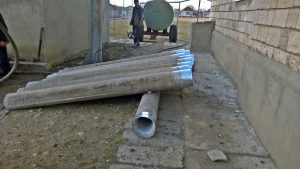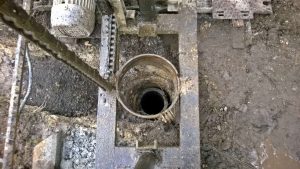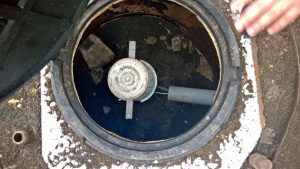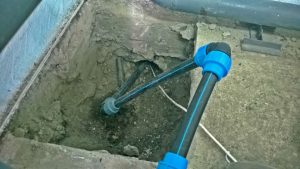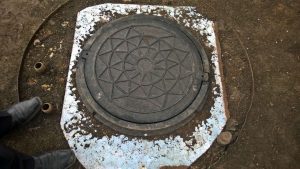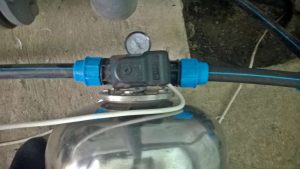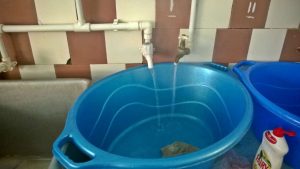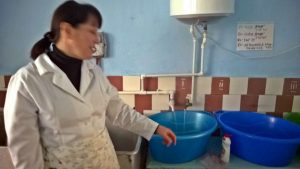The project to build a well to provide for the water needs of the Frumuşica High School has been completed under the direction of Peace Corps Volunteer Aana Barabas.
To read about the beginning of this project, CLICK HERE.
Aana reports:
My Story
At the local high school, there were a number of cases of communicable diseases (hepatitis A and diarrhea) among the students and staff due to lack of clean, running water. However, the major issue was that the school had the infrastructure and resources to promote healthy habits and behaviors but they lacked the main component which was clean, consistent, running water.The school had sinks, indoor restrooms and a cafeteria, but the unreliable water source made it extremely difficult to wash hands during critical times, and caused the closure of the indoor restrooms. This resulted in the students and staff using the outhouse facilities. Female students who were on their menstrual cycle were not comfortable using the outhouse facilities, causing most of them to go home.
The school, parents and community came together and recognized that the unreliable water was the main factor to many of the school’s problems and the health issues of the students. A project team was created to tackle this problem. They wanted to promote the importance of clean, filtered, consistent running water and its role in the prevention of many communicable diseases.
Two health campaigns were conducted by the health teachers and the health club, promoting clean water and educating menstrual/reproductive health among the students and staff.
The project resulted in the construction of the water well and running a water line to the school, providing a reliable, clean water source to the cafeteria, sinks and indoor restrooms.
Students and staff now have the opportunity to use the school facilities, including the bathrooms for sanitation and the sinks for handwashing. They also can safely and effectively use the cafeteria for cooking and eating.
Goals Achieved, Changes in Initial Objectives, and Community Feeling
The project goal was to reduce the number of future cases of Hepatitis A by 30% through clean, filtered running water. The results will not be seen until a year when the school can do a complete comparison among the students and staff. However, 145 students and 25 staff members attended and participated in a water seminar, learning about the importance of water, how to clean and filter water and the communicable diseases associated with dirty water. 83% of students were able to explain how to clean water and 68% were able to identify 3 preventable measures for reducing hepatitis A and other communicable diseases.Among the school staff, 87% were able to explain how to properly clean and filter water and 74% were able to identify 3 preventable measures for reducing hepatitis A. Also 70% of female students (4th-12th grade) and staff attended a seminar about menstrual and reproductive health.
The community is very grateful and ecstatic about having water for the school. Constructing a water well is considered a “saint” act and they believe that the water will help with present and future of the students’ health.
Capacity and Skills Built
This project has strengthened numerous skills among the school and the community. Health and prevention are being promoted among the students and staff. The project team has shown tremendous progress with organizing and implementing this and previous small projects. This is the second small project that they worked on with the Peace Corps, and each time, they are becoming more confident with running needs assessments, organizing health campaigns, writing the grant proposals and creating the project budget.The project team has been working on networking with other villages, discussing health issues and promoting how health should be prioritized, especially essential aspects such as providing clean, running water in the school.The female students are being more comfortable with being at school during their menstrual cycle and understand that privacy is important. The students are consistently being encouraged and motivated to wash their hands and drink clean water. The health teachers are working with the homeroom teachers to create those health habits and the idea that prevention is the first step to living a health life.
Sustainability
The sustainability of this project is through education and awareness of the importance of clean water, how to have clean water and how to prevent communicable diseases that is associated with water. In the health education program, water, hygiene and communicable diseases are in the curriculum and taught throughout the school year. Homeroom teachers are responsible for encouraging students to be hygienic such as washing their hands before meals and after using the restroom, and also promoting drinking clean water. The school’s facilities, such as the sinks and indoor restrooms, will be available for all especially the female students during their menstrual cycle who need privacy and a hygienic setting.The school’s groundskeepers and maintenance team will be responsible for monitoring and maintaining the water pump and pipes. They were involved with the construction and installation of the well, so they now have the knowledge to properly replace or fix anything if a problem does arise. The school and parent association are in charge of the replacement of the water filter as needed, usually every 3 to 5 years.
We are grateful to Aana for completing this important project.
We are still seeking donations.
